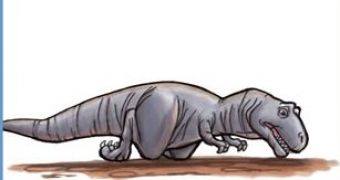Since its discovery, this beast puzzled the researchers.
Tyrannosaurus rex, which lived in western North America 70 to 65 million years ago, till the disappearance of all the dinosaurs, was amongst the largest ever known land predators: the largest females reached 13 m (40 ft) length and 6.8 tons in weight.
But when Henry Fairfield Osborn, the famous American paleontologist, discovered the first T. rex bones, he refused to believe initially that the diminutive arm bone, connected with this enormous beast, really belonged to it.
When further skeletons showed that the tiny two-digits arms indeed belonged to Tyrannosaurus, he emitted the first theory in 1906 of their purpose: grasping organs for copulation, the way python males still possess spurs representing reduced hind limbs for this goal.
British paleontologist Barney Newman expressed the opinion in 1970, saying that the arms could act as braces to impede skidding forward as the animal rose employing its hind limbs.
Other theory regards the arms as meat hooks while the creature's teeth were employed. It's difficult to prove any of these theories, but the recent discovery of a complete skeleton of T. rex forelimbs in Northern Montana offers the possibility to check their biomechanical and osteopathic traits.
Clearly, the hands could not reach its mouth and the elbow could not move beyond a 90-degree angle. The arms could lift up nearly 400 pounds (100 kg) in a very limited range of motions but the wrists were much weaker and could not support large mechanical loads.
The weal arms were often broken during life, which suggests that T-rex could not employ its arms up to a month, thus the Newman's theory is discarded.
In this case, how did the enormous beast get up?
You just have to look at the birds, which are living dinosaurs, to see this: they cannot use their forelimbs, for obvious reasons (they are turned into wings).
Birds just put one limb below the center of gravity and after that, they extend the other. Tyrannosaurs could do this easily, and even more, as they had the help of their s long tail. The tail helped to keep the center of gravity back on the body as the hindlimbs were positioned for getting up.

 14 DAY TRIAL //
14 DAY TRIAL //